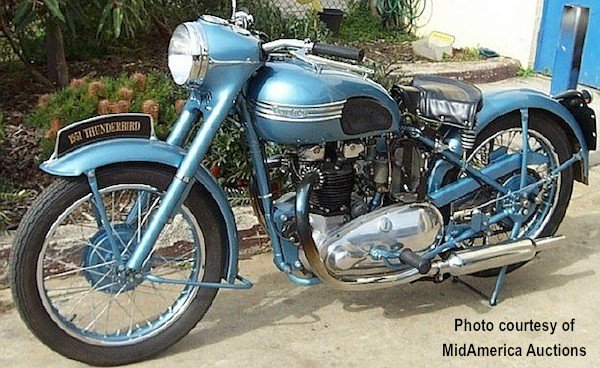1953 Triumph Thunderbird
Sitting in for the 1953 Triumph Thunderbird is this lovely 1951 T-Bird. Very similar to the 1953 model, they share in common the rigid frame with sprung rear hub, forks, brakes, bodywork & cycle gear. Paint colors & minor trim features vary. Unfortunately, no photo was available at this time of a proper 1953 T-bird, so we had to make do with this. We need pictures of your bike to help round out our inventory. If you have a 1953 Triumph Thunderbird, please SEND PICTURES!
MODERN ELECTRICS
The ’53 T-Bird benefited from the switch to alternator electrics, points & coils for ignition. Gone were the old magneto (spark) & dynamo (lights). The new electrics appeared first on the 500cc 5T, then began appearing on other models throughout the model year.
PRIMARY SIDE
The new Lucas RM12 alternator lived in the primary chaincase on the outer left end of the crankshaft. Changes to the primary cases were made to accomodate & a large, elegant bulge appeared on the outer primary case that would evolve into the lovely Triumph logo that would appear on later Unit Construction twins. The points were located in a distributor which occupied the space behind the cylinders where the magneto used to live, and was driven by the same method: gear-driven off the inlet cam gear.
NEW ELECTRICAL SYSTEM
The 1953 Triumph Thunderbird had no means of voltage regulation, just a simple full-wave, 2-plate rectifier under the seat for converting AC to DC current. In case of a dead battery, an “Emergency” switch brought the alternator’s full output into the ignition circuit, making it easier to start. The old magnetos were self-sufficient & would start no matter what. These new-fangled alternators & coils were suspect in the eyes of the public. Engine mounting plates were modified to deal with the absence of the dynamo.

1953 TRIUMPH THUNDERBIRD – ENGINE SHOCK ABSORBER
One nice feature that pre-unit Triumph twins had prior to the alternator was a very neat engine shock absorber that occupied the place at the left end of the crank now taken by the new alternator. This shock absorber was really an ingenious contraption. It was comprised of two pieces cammed to one another with ramps & pushed together with a spring. One was hooked to the crank & the other to the primary engine sprocket. It allowed a certain amount of “give” in the form of some controlled slippage in both directions between the two pieces along their ramps, against the spring tension attempting to clamp them together. This served to quell engine vibrations so effectively that it made everything last longer: engine bearings, primary chain, gearbox, even the final drive chain were reputed to last longer due to the smoothing effect of the shock absorber. Unfortunately, this brilliant innovation had to be dumped to make room for the alternator. Attempts were made to accomplish the same task with a shock absorber inside the clutch hub, but nothing worked as well.
1953 TRIUMPH THUNDERBIRD – TEETHING PROBLEMS
The early alternator systems had problems. The distributor was inaccessible, the wiring much more complex. The only way to get full power out of the alternator was to turn on the headlights. This triggered the alternator to go from 4 stator windings to 6. The critical air gap between alternator rotor & stator was proving vulnerable to play in the bottom end. Many fixes were tried, but not until the resin-encased the stator in 1968 did the problem truly get solved. Loose primary chains would also eat into the alternator wiring.
1953 TRIUMPH THUNDERBIRD – DISTRIBUTOR GREMLINS
The distributor too was fraught with problems. It had one set of points & one coil, with a rotor & distributor cap, car-style. The small dimensions of the bushings also caused excessive wear.
1953 TRIUMPH THUNDERBIRD – NEW ELECTRICS
While there were some early problems with the new electrical system, for the most part, the change was progress. And the good thing about alternators & points was that, when they did fail, the were much less costly than replacing a magneto or dynamo. However, magnetos were retained on some pre-unit sport models, as racers preferred them & Triumph Motorcycles didn’t want to lose their business to BSA or Norton, who were still offering the mag.
1953 TRIUMPH THUNDERBIRD – CARRYOVER
Otherwise, the 1953 Triumph Thunderbird was pretty much carried over from 1952. The same rigid frame & sprung rear hub that had been with us since the War were on their last year. 1954 would see the introduction, finally, of a proper swing arm rear suspension.
1953 Triumph Thunderbird SPECIFICATIONS
|
Engine type Displacement Bore & Stroke Compression Carburetor Ignition Engine output Primary drive Primary sprockets Clutch Gearbox Ratios, overall: 1st, bottom 2nd 3rd 4th, top Final drive Final drive sprockets Frame Type Suspension, front Suspension, rear Brake, front Brake, rear Tire, front Tire, rear Wheelbase Seat Height Ground Clearance Fuel capacity Dry weight |
Air-cooled OHV vertical twin, non-unit 649cc / 40.0 ci 71mm X 82mm / 2.79″ X 3.23″ 8.5:1 (US & export); 7.0:1 (UK) 1- SU Type MC2 Lucas magneto 34 bhp @ 6500 rpm 1/2″ X .335″ X 5/16″ chain, 70 links 24T X 43T Multi-plate, wet 4-speed constant mesh, right foot shift
11.9:1 8.25:1 5.81:1 4.88 5/8″ X .400″ X 3/8″ chain, 101 links 18T X 46T Brazed lug, rigid Telescopic fork, hydraulic damping Sprung rear hub, rigid frame 7″ SLS drum 7″ SLS drum 3.25″ X 19″ 3.50″ X 19″ 55.25″ / 140.3 cm 31″ / 77.5 cm 5″ / 12.7 cm 3 Imp gal (US); 4 Imp gal (UK & export) 370 lbs / 168 kg |



No Comment